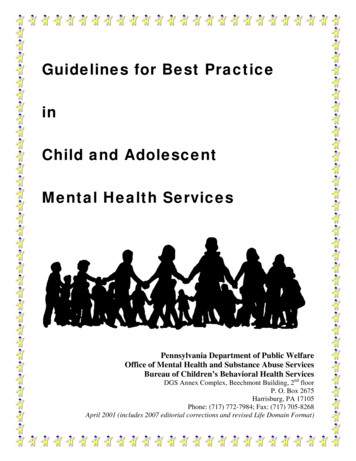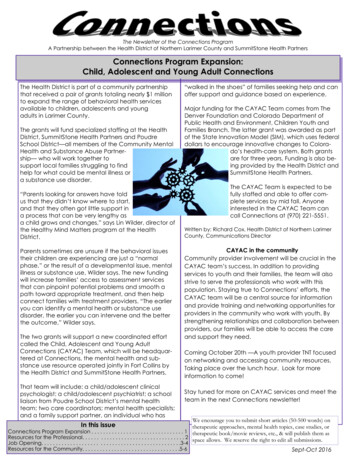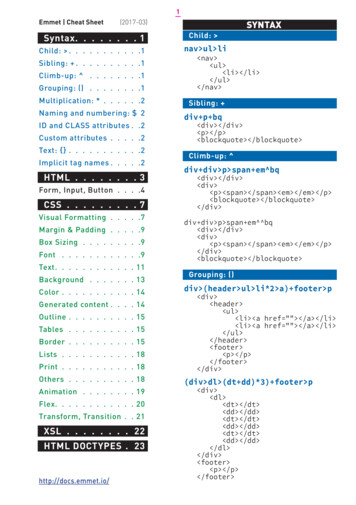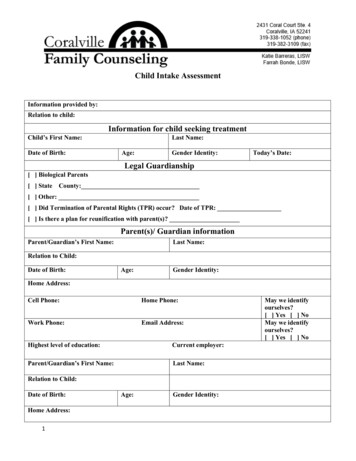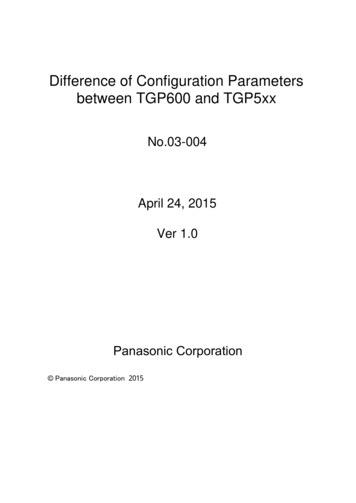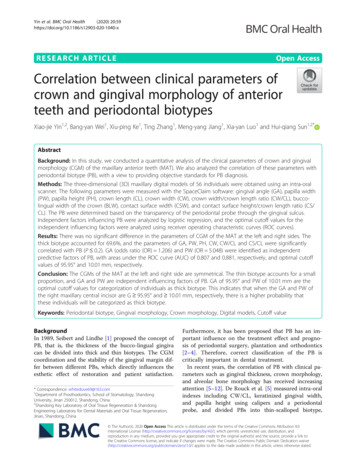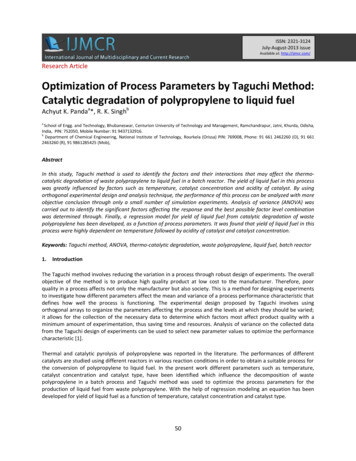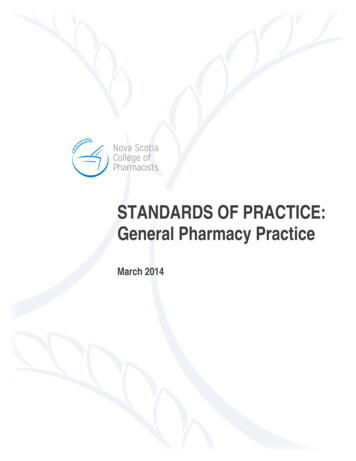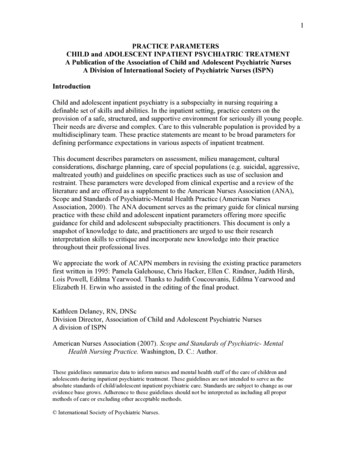
Transcription
1PRACTICE PARAMETERSCHILD and ADOLESCENT INPATIENT PSYCHIATRIC TREATMENTA Publication of the Association of Child and Adolescent Psychiatric NursesA Division of International Society of Psychiatric Nurses (ISPN)IntroductionChild and adolescent inpatient psychiatry is a subspecialty in nursing requiring adefinable set of skills and abilities. In the inpatient setting, practice centers on theprovision of a safe, structured, and supportive environment for seriously ill young people.Their needs are diverse and complex. Care to this vulnerable population is provided by amultidisciplinary team. These practice statements are meant to be broad parameters fordefining performance expectations in various aspects of inpatient treatment.This document describes parameters on assessment, milieu management, culturalconsiderations, discharge planning, care of special populations (e.g. suicidal, aggressive,maltreated youth) and guidelines on specific practices such as use of seclusion andrestraint. These parameters were developed from clinical expertise and a review of theliterature and are offered as a supplement to the American Nurses Association (ANA),Scope and Standards of Psychiatric-Mental Health Practice (American NursesAssociation, 2000). The ANA document serves as the primary guide for clinical nursingpractice with these child and adolescent inpatient parameters offering more specificguidance for child and adolescent subspecialty practitioners. This document is only asnapshot of knowledge to date, and practitioners are urged to use their researchinterpretation skills to critique and incorporate new knowledge into their practicethroughout their professional lives.We appreciate the work of ACAPN members in revising the existing practice parametersfirst written in 1995: Pamela Galehouse, Chris Hacker, Ellen C. Rindner, Judith Hirsh,Lois Powell, Edilma Yearwood. Thanks to Judith Coucouvanis, Edilma Yearwood andElizabeth H. Erwin who assisted in the editing of the final product.Kathleen Delaney, RN, DNScDivision Director, Association of Child and Adolescent Psychiatric NursesA division of ISPNAmerican Nurses Association (2007). Scope and Standards of Psychiatric- MentalHealth Nursing Practice. Washington, D. C.: Author.These guidelines summarize data to inform nurses and mental health staff of the care of children andadolescents during inpatient psychiatric treatment. These guidelines are not intended to serve as theabsolute standards of child/adolescent inpatient psychiatric care. Standards are subject to change as ourevidence base grows. Adherence to these guidelines should not be interpreted as including all propermethods of care or excluding other acceptable methods. International Society of Psychiatric Nurses.
2ACAPN INPATIENT PRACTICE PARAMETERSCONTENTSASSESSMENT OF THE CHILD AND ADOLESCENT 3PRINCIPLES OF THERAPEUTIC MILIEU 8USE OF PHYSICAL RESTRAINTS AND SECLUSION 15MANAGEMENT OF AGGRESSION 25ASSESSMENT OF SUICIDE RISK 33SEXUAL ABUSE 39TRANSCULTURAL CARE 46DISCHARGE PLANNING 51
3ASSESSMENT OF THE CHILD AND ADOLESCENT DURING BRIEFINPATIENT PSYCHIATRIC TREATMENTDESCRIPTION/OVERVIEW:During inpatient hospitalization, psychiatric nurses are afforded a unique assessmentopportunity by virtue of their 24-hour presence on the unit. They observe and interactwith patients and significant others with the purpose of assessing behaviors, symptomsand responses to intervention in the milieu. Because of their continuous presence nurseshave the opportunity to recognize patterns of behaviors, symptoms, deficits, thoughts andbeliefs; and to communicate these to other members on the team. Inpatient units typicallyadmit children with a variety of mood, behavioral and neurobiological disorders as wellas children with significant physical or mental co-morbidities. Thus assessment must beholistic, and the data collected using reliable and valid methods.DESIRED OUTCOME:Assessment data will be compiled that reflects the child’s current status, accuratelydetermines symptoms, and describes how the child/adolescent functions in activities ofdaily living and in therapeutically designed activities. These activities will vary instructure and task demands. Nurses will assess for any difficulties with regulation ofaffect or behavior associated with situations such as transitions, activities of daily living(e.g. concentrating on homework), visiting with family members, peer interaction, orperiods when the pace and noise level of the milieu increases or decreases. Responses totreatment are documented. The nurse also assesses how the child/adolescent views theirillnesses and how effective adults are, as they interact, nurture, discipline and supportthem in managing their acute illness. Finally, assessment will include any potentialbarriers to discharge to a less restrictive environment and what services or referrals canincrease the likelihood of a successful transition.A. ASSESSMENTPrinciple of CareThe child/adolescent and family canexpect:A thorough assessment of currentbehavior, centered on issues thatprompted admission.An opportunity to explain theirperceptions of the behaviors andsymptoms that prompted admission.A holistic assessment is conductedincluding physical and psychiatric issues.Any unstable medical conditions aremonitored.PracticeThe nurse will:Be proficient in understandingdevelopmental, cultural, spirituality andgender differences in the presentingpatients.Utilize reliable and valid methods tocollect data; synthesize findings andcommunicate these with other membersof the team.Complete a review of systems asspecified on the nursing admission database.
4The assessment reflects not only healthbehaviors or symptoms, but other factorsintegral to the child’s functioning, suchas strengths, affect regulation, supportsystem, coping and stress response,information processing, relatedness andcontrol.Assessment includes evaluation of thechild’s functioning within peer groups,the family, school, and the neighborhood/community.There will be continuous assessment ofany behaviors/thoughts that indicate adanger to self or others. When knownrisk factors are present anticipatoryplanning will be done.The plan of care that is developed isbased on the assessment and reflects asynthesis of all relevant data.The plan of care reflects patient-centeredgoals and family involvement inestablishing those goals.The patient, family and legal guardianswill understand the unit policies abouthow assessment data is collected and willparticipate in the process.The assessment process will include adiscussion of confidentiality, trust and thenature of the nurse-patient- guardianrelationship.Assess the child/adolescent for:-Current behavior, thoughts, mood andaffect, and how they compare withparent/child report pre-admission-Review of medications: current, pastyears, side/adverse effects, dosageadjustments and response-Situational or relational variables thatare related to increased or diminishedintensity of problem behaviors-Any verbal or non-verbal signs ofdanger to self or others (See additionalguidelines detailed in section onmonitoring suicidal behavior)-Substance use: type, amount, frequency,context. Include legal, illegal, over thecounter, and psychoactive substances-Legal involvement-Traumatic events (recent and remote)-Achievement of developmentalmilestones-Functional limitations that may impactdischarge planning-Any co-occurring medical conditions.Obtain history of psychiatric treatment.Assess the family for ability to providefor the patient’s needs post discharge.Assess for any potential barriers fordischarge to the least restrictiveenvironment.B. DIAGNOSESAssessment could result in any number of nursing diagnoses, including but not limited to:Impaired social interactionAltered role performanceAltered growth and developmentRisk for injury/Risk for violence self directed or otherSelf-care deficitIneffective coping
5C. PLANNINGPrinciple of CareA complete assessment of the patient’sbehavior requires planning for the ongoing assessment of milieu behavior.This milieu assessment of behaviordemands:PracticeThe nurse will:Plan opportunities to assess functioningin a variety of situations (e.g. with peers,doing structured an unstructured tasks)and determine if variation exists.Observing and interacting with thechild/adolescent in a variety of milieusettings that includes different levels ofstimulation and task demands.Include a plan for systematicallyengaging with primary guardians.Obtaining parent/guardian perceptions ofmilieu behavior.Scheduling times to discuss staffobservations of milieu behaviors with theparent/guardian.Assuring that sufficient numbers ofappropriately trained staff are assigned todetect variations in behaviors, affects,functioning and response to treatment.Providing continuity of staff to promotetrust and rapport and enable ongoingassessment.Inclusion of knowledge deficits that willinform both treatment and dischargeplanning.Allow multiple staff to assess behavior ina variety of situations.Plan staffing to ensure consistency withpatient assignments, facilitate thedevelopment of the therapeuticrelationship and thus enable assessmentof changes in response to treatment.Consult with the literature whennecessary to ensure that all relevantfactors are assessed.Communicate and collaborate indeveloping this plan with themultidisciplinary team.Integrate assessment findings andprioritize.D. IMPLEMENTATIONPrinciple of CareImplementing the assessment processrequires the nurse has knowledge of all ofthe psychiatric disorders, and of thephysiological illnesses that haveassociated psychiatric symptoms.PracticeThe nurse will:Identify patterns of behaviors over timeand identify antecedents or consequencesof behavior.Utilize assessment tools as appropriate togather quality data.
6In assessing youth the nurseacknowledges:Observe the patient in a variety of milieuand group situations.The number of stressors prior toadmission is related to child’spresentations and adjustment in thehospital.Discuss incidents and behaviors withpatient to ascertain their perceptions andattributions.Assessments will be individualized to theneeds of the child, and will be conductedusing therapeutic tools, reliable and validmethods.Therapeutic interactions for the purposeof assessment will take into considerationthe nature of the stressors and symptoms,as well as gender or cultural issues thatmay impact disclosure.Discuss observations with parent orguardian to compare and contrast milieubehaviors with home behaviors.Provide constant supervision so thatbehaviors indicative of danger to self orothers can be observed. ( See additionalguidelines on suicidal patients)Consider the relative impact of stressorsin school, peer group and neighborhoodon adjustment.E. EVALUATIONPrinciple of CareAssessment of behaviors is an ongoingprocess that provides information usefulto diagnosis, treatment, and dischargeplanning.PracticeThe nurse will:Communicate staff’s assessment ofpatient’s milieu behavior to the treatmentteam.Inpatient facilities that experienceoptimal outcomes use a systematicprocess of risk management, independentauditing of programs and policies, andevaluating their practices against ‘bestevidence’ in the literature.Conduct and participate in discussionsamong nursing staff to reach commonunderstanding of the child or adolescent.Refine assessment as new data emergesand/or behaviors or symptoms change.Consult the literature as needed.
7RESOURCESAmerican Academy of Child and Adolescent Psychiatry (1997). Practice parameters forthe psychiatric assessment of children and adolescents. Journal of the AmericanAcademy of Child and Adolescent Psychiatry, 36 (10 Supplement), 4S-20S.Delaney, K.R. (in press). Special Edition: Milieu Assessment of Behavior. Journal ofChild and Adolescent Psychiatric Nursing.Greenspan, S. I. & Greenspan, N. T. (2003). The clinical interview of the child.Washington, D. C: American Psychiatric Association.Joint Commission on Accreditation of Health Care Organizations (2003). Assessingcognitive and emotional functioning across the continuum of care. Oakbrook Terrace,Illinois: Author.Kronenberger, W. C., Carter, B. D., & Thomas, D. (1997). Assessment of behaviorproblems in pediatric inpatient settings: Development of a Pediatric InpatientBehavior Scale. Children’s Health Care, 26, 221-232.Lyall, D., Hawley, C., & Scott, K. (2004). Nurses’ observation scale for inpatientevaluation: Reliability update. Journal of Advanced Nursing, 46, 390-394.Thienemann, M. (2004). Introducing a structured interview into a clinical setting. Journalof the American Academy of Child and Adolescent Psychiatry, 43, 1057-1060.
8PRINCIPLES Of THE THERAPEUTIC MILIEU APPIED TO PSYCHIATRICHOSPITALIATIZATION FOR CHILDREN AND ADOLESCENTSDESCRIPTION/OVERVIEW:Inpatient psychiatric nurses are the “gatekeepers of the milieu.” They assumeresponsibility for the milieu’s tone, pace and activity level. They assure that the milieu issafe, structured and supportive. Further, they assure the milieu is engineered so that thechild/adolescent succeeds and begins to build a sense of control in their lives. Atherapeutic milieu consists of five components: safety, structure, support, involvementand validation. Inpatient units are typically locked and the young person’s movementsabout the space are restricted (e.g. visitation between patients in their rooms).Containment limits a child/adolescent’s autonomy and freedom of will and separatesthem from sources of support such as parents and peers. Also, adults possess control thatcan be intimidating or anxiety provoking for many young patients, especially those whohave been victimized. For many youth, the issue of containment is extremely stressfuland impacts their coping and behavior on the unit.Structure in the milieu comes from unit policies and procedures, the practice behavior ofthe staff, and from incorporating existing knowledge about therapeutic activities
The nurse will: Plan opportunities to assess functioning in a variety of situations (e.g. with peers, doing structured an unstructured tasks) and determine if variation exists. Include a plan for systematically engaging with primary guardians. Allow multiple staff to assess behavior in a variety of situations.
